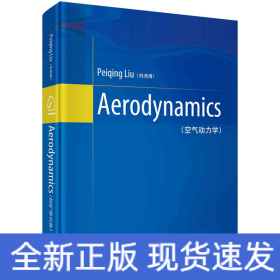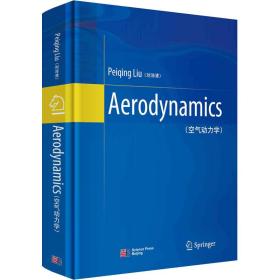
空气动力学(英文版)
批量上传,套装书可能不全,下单前咨询在线客服! 正版书 !!!
¥ 285.06 7.2折 ¥ 398 全新
库存8件
四川成都
认证卖家担保交易快速发货售后保障
作者刘沛清
出版社科学出版社
ISBN9787030729446
出版时间2022-10
装帧精装
开本16开
定价398元
货号29501578
上书时间2024-10-22
- 最新上架
商品详情
- 品相描述:全新
- 商品描述
-
导语摘要
This textbook highlights the fundamentals of aerodynamics and the applications in aeronautics. The textbook is divided into two parts: basic aerodynamics and applied aerodynamics. The first part focuses on the basic principles and methods of aerodynamics. The second part covers the aerodynamic characteristics of aircraft in low speed, subsonic, transonic and supersonic flows. The combination of the two parts aims to cultivate students’ aerospace awareness, build the ability to raise and solve problems and the ability to make comprehensive use of the knowledge to carry out innovative practice.
目录
Contents
Part I Fundamentals of Aerodynamics
1 Introduction 3
1.1 Aerodynamics Research Tasks 3
1.2 History of Aerodynamics 6
1.2.1 Qualitative Knowledge and Practice 6
1.2.2 Low Speed Flow Theory"10
1.2.3 High-Speed Flow Theory 26
1.3 The Leading Role of Aerodynamics in the Development of Modem Aircraft 31
1.4 Aerodynamics Research Methods and Classification 33
1.5 Dimension and Unit 37
Exercises 38
2 Basic Properties of Fluids and Hydrostatics 41
2.1 Basic Properties of Fluids 41
2.1.1 Continuum Hypothesis 41
2.1.2 Fluidity of Fluid 44
2.1.3 Compressibility and Elasticity of Fluid 46
2.1.4 Viscosity of Fluid (Momentum Transport of Fluid) 47
2.1.5 The Thermal Conductivity of the Fluid (The
Heat Transport of the Ruid) 53
2.1.6 Diffusivity of Fluid (Mass Transport of Fluid) 54
2.2 Classification of Forces Acting on a Differential Fluid Element 56
2.3 Isotropic Characteristics of Pressure at Any Point in Static Fluid 58
2.4 Euler Equilibrium Differential Equations 60
2.5 Pressure Distribution Law in Static Liquid in Gravitational Field 65
2.6 Equilibrium Law of Relative Static Liquid 71
2.7 Standard Atmosphere 72
Exercises 77
3 Foundation of Fluid Kinematics and Dynamics 85
3.1 Methods for Describing Fluid Motion 86
3.1.1 Lagrange Method (Particle Method or Particle System Method) 86
3.1.2 Euler Method (Space Point Method or Flow Field Method) 88
3.2 Basic Concepts of Flow Field 94
3.2.1 Steady and Unsteady Fields 94
3.2.2 Streamline and Path Line 95
3.2.3 One-Dimensional, Two-Dimensional and Three-Dimensional Hows 98
3.3 Motion Decomposition of a Differential Fluid Element 99
3.3.1 Basic Motion Forms of a Differential Fluid Element 99
3.3.2 Velocity Decomposition Theorem of Fluid Elements 104
3.4 Divergence and Curl of Velocity Field 106
3.4.1 Divergence of Velocity Field and Its Physical106
Significance 3.4.2 Curl and Velocity Potential Function of Velocity Field 109
3.5 Continuous Differential Equation 112
3.5.1 Continuity Differential Equation Based on Lagrange View 112
3.5.2 Continuity Differential Equation Based on Eulerss Viewpoint 113
3.6 Differential Equations of Ideal Fluid Motion (Euler Equations) 116
3.7 Bernoulli^ Equation and Its Physical Significance 120
3.7.1 Bernoulli Equation 120
3.7.2 Application of Bernoulli Equation 125
3.8 Integral Equation of Fluid Motion 133
3.8.1 Basic Concepts of Control Volume and System 133
3.8.2 Lagrangian Integral Equations 135
3.8.3 Reynolds Transport Equation 137
3.8.4 Eulerian Integral Equations 141
3.8.5 Reynolds Transport Equation of the Control Volume with Arbitrary Movement Relative to the Fixed Coordinate System 143
3.9 Vortex Motion and Its Characteristics 145
3.9.1 Vortex Motion 145
3.9.2 Vorticity, Vorticity Flux and Circulation 148
Exercises 181
4 Plane Potential Flow of Ideal Incompressible Fluid 189
4.1 Basic Equations of Plane Potential Flow of Ideal Incompressible Fluid 189
4.1.1 Basic Equations of Irrotational Motion of an Ideal Incompressible Fluid 190
4.1.2 Properties of Velocity Potential Function 192
4.1.3 Stream Functions and Their Properties 194
4.1.4 Formulation of the Mathematical Problem of Steady Plane Potential Flow of Ideal Incompressible Fluid 199
4.2 Typical Singularity Potential Flow Solutions 200
4.2.1 Uniform Flow 201
4.2.2 Point Source (Sink) 202
4.2.3 Dipole 204
4.2.4 Point Vortex 207
4.3 Singularity Superposition Solution of Flow Around Some Simple Objects 210
4.3.1 How Around a Blunt Semi-infinite Body 210
4.3.2 Flow Around Rankine Pebbles 214
4.3.3 Flow Around a Circular Cylinder Without Circulation 217
4.3.4 Flow Around a Cylinder with Circulation 222
4.4 Numerical Method for Steady Flow Around Two-Dimensional Symmetrical Objects 227
Exercises 232
5 Fundamentals of Mscous Fluid Dynamics 235
5.1 The Viscosity of Fluid and Its Influence on Flow 235
5.1.1 Viscosity of Fluid 236
5.1.2 Characteristics of Viscous Fluid Movement 236
5.2 Deformation Matrix of a Differential Fluid Element 239
5.3 Stress State of Viscous Fluid 241
5.4 Generalized Newton’s Internal Friction Theorem (Constitutive Relationship) 245
5.5 Differential Equations of Viscous Fluid MotionNavier-Stokes Equations 249
5.5.1 The Basic Differential Equations of Fluid Motion 249
5.5.2 Navier-Stokes Equations (Differential Equations of Viscous Fluid Motion) 250
5.5.3 Bernoulli Integral 252
5.6 Exact Solutions of Navier-Stokes Equations 255
5.6.1 Couette Flow (Shear Flow) 256
5.6.2 Poiseuille Flow (Pressure Gradient Flow) 257
5.6.3 Couette Flow and Poiseuille Flow Combination 259
5.6.4 Vortex Column and Its Induced Flow Field 263
5.6.5 Parallel Flow Along an Infinitely Long Slope Under Gravity 268
5.7 Basic Properties of Viscous Fluid Motion 271
5.7.1 Vorticity Transport Equation of Visco
内容摘要
This textbook highlights the fundamentals of aerodynamics and the applications in aeronautics. The textbook is divided into two parts: basic aerodynamics and applied aerodynamics. The first part focuses on the basic principles and methods of aerodynamics. The second part covers the aerodynamic characteristics of aircraft in low speed, subsonic, transonic and supersonic flows. The combination of the two parts aims to cultivate students’ aerospace awareness, build the ability to raise and solve problems and the ability to make comprehensive use of the knowledge to carry out innovative practice.
相关推荐
— 没有更多了 —





















以下为对购买帮助不大的评价